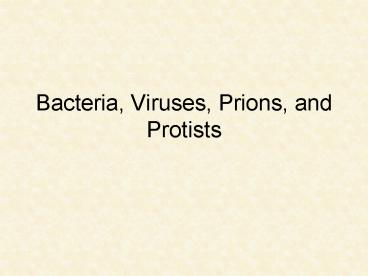Bacteria, Viruses, Prions, and Protists - PowerPoint PPT Presentation
1 / 50
Title:
Bacteria, Viruses, Prions, and Protists
Description:
Cell walls of Eubacteria have peptidoglycans while those of ... Tooth decay. Lyme disease. Tetanus. Tuberculosis. Salmonella food poisoning. Pneumonia ... – PowerPoint PPT presentation
Number of Views:536
Avg rating:3.0/5.0
Title: Bacteria, Viruses, Prions, and Protists
1
Bacteria, Viruses, Prions, and Protists
2
Bacteria
- Unicellular or Multicellular?
- Prokaryotic or Eukaryotic?
- Cells Walls?
3
Bacteria
- Unicellular
- Prokaryotes
- Cells walls containing peptidoglycan
4
Bacteria
- Extremely Abundant
- Cover nearly every square centimeter of Earth
5
What are the differences between eubacteria and
archaebacteria?
6
Eubacteria versus Archaebacteria
- Cell walls of Eubacteria have peptidoglycans
while those of Archaebacteria do not. - DNA sequences of archaebacteria is more similar
to that of eukaryotes than to the DNA of
eubacteria - Archaebacteria often live in very extreme
environments (hot springs, digestive tracts,
Great Salt Lake, etc.)
7
Bacterial Shapes
- Bacilli rod shaped
- Cocci spherical
- Spirilla spiral, corkscrew
8
(No Transcript)
9
Grouping of Bacteria
- Diplo- Groups of two
- Strepto- chains
- Staphylo- Grapelike clusters
10
Diplococcus
11
Streptococcus Causes Strep Throat
12
Staphylococcus
13
Bacillus - E. coli
14
(No Transcript)
15
Cell Walls
- Gram positive stain violet due to thick
peptidoglycan walls - Gram negative stain pink/red, have much thinner
walls inside lipid layer
16
Metabolism
- Heterotrophs
- Chemoheterotrophs must take in organic molecules
and a supply of carbon - Photoheterotrophs are photosynthetic but also
need to take in organic molecules for carbon
source
17
Metabolism
- Photoautotrophs use light energy to make carbon
compounds - Chemoautotrophs use energy from chemical
reactions to make carbon compounds - Where might each type of bacteria be found?
18
Binary Fission
- When a bacteria grows so that it has doubled in
size, it replicates its DNA and divides in half - Is this sexual or asexual?
- Identical or different daughter cells?
19
Conjugation
- Some bacteria are able to exchange genetic
information - A hollow bridge forms between two bacteria and
genes move from one cell to the other - Increases genetic diversity of a population
20
Pili
- Short protein appendages
- Smaller than flagella
- Adhere bacteria to surfaces
- Used in conjugation for Exchange of genetic
information - Aid Flotation by increasing buoyancy
21
Pili in Conjugation
22
Conjugation
23
Spore Formation
- Spores are formed when the bacteria produces a
thick internal wall that encloses the DNA and
part of the cytoplasm - Why do you think this would be beneficial for
bacteria?
24
Spore Formation
- Occurs when conditions are unfavorable for growth
- Can remain dormant for years until conditions
improve
25
Spore Formation
26
What are some benefits of bacteria?
27
Benefits of Bacteria
- Some are producers that undergo photosynthesis
- Some are decomposers that break down dead matter
to recycle the nutrients - Some convert nitrogen gas to a form that can be
used by plants (nitrogen fixation)
28
What are some dangers of bacteria?
29
Dangers of Bacteria
- Break down cells and tissues for food
- Example Tuberculosis (destroys lung tissue)
- Release toxins (poisons) that travel through the
body - Example Streptococcus releases toxins into the
blood stream causes strep throat and scarlet fever
30
Common Diseases Caused by Bacteria
Section 19-3
Disease
Pathogen
Prevention
Regular dental hygiene Protection from tick
bites Current tetanus vaccination Vaccination Prop
er food-handling practices Maintaining good
health Clean water supplies
Tooth decay Lyme disease Tetanus Tuberculosis Salm
onella food poisoning Pneumonia Cholera
Streptococcus mutans Borrelia burgdorferi Clostrid
ium tetani Mycobacterium tuberculosis Salmonella
enteritidis Streptococcus pneumoniae Vibrio
cholerae
31
Vaccines
- A vaccine is a preparation of weakened or killed
pathogens that are injected into the body - This stimulates the body to produce immunity to
the disease
32
Vaccines
- Why do you think we dont vaccinate everyone for
all disease we have created vaccines for?
33
Antibiotics
- Antibiotics block the growth and reproduction of
bacteria - Used to treat bacterial infections
34
Solve the Problem
- What would you do to find out what causes the
tobacco leaves to be diseased?
35
Viruses
- A virus is a core of DNA or RNA surrounded by a
protein coat (capsid)
36
Viruses
- They can only reproduce by infecting living cells
- They enter a cell and use its cell machinery to
produce more viruses
37
Common Diseases Caused by Viruses
Section 19-3
Type of Virus
Nucleic Acid
Disease
Cancer Cancer, AIDS Respiratory
infections Chickenpox Smallpox
Oncogenic viruses Retrovirus Adenoviruses Herpesvi
ruses Poxviruses
DNA RNA DNA DNA DNA
38
Retroviruses
- Contain RNA as genetic information instead of DNA
39
Are Viruses Living?
- Cannot reproduce alone, must have a host cell
- Do not undergo growth or development
- Do not obtain or use energy
- Evolve
40
Figure 19-11 Viruses and Cells
Section 19-2
41
Prions
- Diseases such as Scrapie (in sheep) and Mad Cow
Disease are not caused by bacteria or viruses.
What could cause them?
42
Prions
- Contain only protein
- Cause disease by forming protein clumps which
then induce normal proteins to become Prions - The build up eventually damages nerve tissue
43
Protists
- Domain?
- Kingdom?
- Prokaryotic or Eukaryotic?
44
Protists
- Domain Eukarya
- Kingdom Protists
- Eukaryotic
45
Protists
- Protists are defined by what they are not.
- Protists are eukaryotes that are not animals,
plants, or fungi. - They were the first eukaryotic organisms on earth.
46
Types of Protists
- Animal-Like Protists heterotrophs
- Plant-Like Protists produce food through
photosynthesis - Fungus-Like Protists obtain food by external
digestion
47
Animal-Like Protists
- Heterotrophs
cilliate
sporozoan
Sarcodine (amoeba)
zooflagellate
48
Animal-Like Protists
- Malaria
- African Sleeping Sickness
49
Plant-Like Protists
- Carry out photosynthesis
50
Fungus-Like Protists
- Grow in damp, nutrient rich environments
- Absorb food through cell membranes































